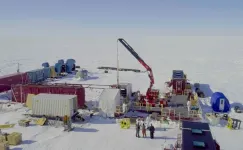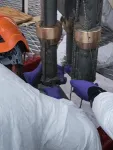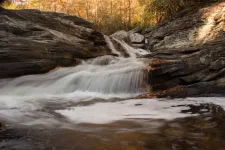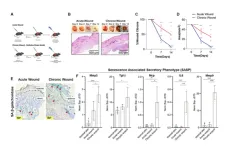(Press-News.org) WASHINGTON — The West Antarctic Ice Sheet is melting rapidly, raising concerns it could cross a tipping point of irreversible retreat in the next few decades if global temperatures rise 1.5 to 2.0 degrees Celsius (2.7 to 3.8 degrees Fahrenheit) above preindustrial levels. New research finds that 6,000 years ago, the grounded edge of the ice sheet may have been as far as 250 kilometers (160 miles) inland from its current location, suggesting the ice retreated deep into the continent after the end of the last ice age and re-advanced before modern retreat began.
“In the last few thousand years before we started watching, ice in some parts of Antarctica retreated and re-advanced over a much larger area than we previously appreciated,” said Ryan Venturelli, a paleoglaciologist at Colorado School of Mines and lead author of the new study. “The ongoing retreat of Thwaites Glacier is much faster than we’ve ever seen before, but in the geologic record, we see the ice can recover.”
The study appears in AGU Advances, which publishes high-impact, open-access research and commentary across the Earth and space sciences. It presents the first geologic constraint for the ice sheet’s location and movement since the last ice age.
The grounding line is where a glacier or ice sheet leaves solid ground and begins to float on water as an ice shelf. Today, the Ross Ice Shelf extends hundreds of miles over the ocean from the grounding line of the West Antarctic Ice Sheet. Because ocean water washes up against the leading edge of the ice, the grounding line can be a zone of rapid melting.
“The concern of grounded ice loss is because the loss of ice on land is what contributes to sea level rise,” Venturelli said. “As grounding lines retreat farther inland, the more vulnerable the ice sheet becomes as it exposes thicker and thicker ice to the warming ocean.”
During the Last Glacial Maximum, about 20,000 years ago, the West Antarctic Ice Sheet was so large that it was grounded on the ocean floor, beyond the edge of the continent. Previous observations generally indicate a steady retreat since then, accelerated in the last century by human-caused climate change.
The question for Venturelli was just how far inland the ice sheet had retreated after the last ice age. Without knowing that, it’s hard to predict how sensitive the Antarctic Ice Sheet is and how it will respond to further climate change.
A lake about twice the size of Manhattan buried under a kilometer (0.6 miles) of ice and sealed off from today’s atmosphere held clues to the answer. To reach it, Venturelli and her team carefully melted their way in with a hot water “drill.” Once they had access, they pulled up samples of lake water and carbon-filled sediments from the lake bed. Using radiocarbon dating, they found the carbon was about 6,000 years old.
Because radiocarbon (carbon-14) in these sediments must have come from seawater, the finding suggests that what is now a lake 150 kilometers (93 miles) from the modern ice edge was the floor of the ocean. When the ice advanced, it capped off the lake, preserving the carbon as part of the lake bottom’s sediments. And based on radiocarbon in water sampled from the same lake, the grounding line could have been 100 kilometers (62 miles) even farther inland at that time.
“When we set out to sample this lake, we weren’t sure what we would find out about ice history, but the fact that deglaciation persisted this far inland was not that wild of a possibility,” Venturelli said. “This area of West Antarctica is really flat. There is nothing to put brakes on the retreat of the grounding line. No real topographical doorstops.”
The new evidence of Antarctic ice’s ability to make a comeback was welcome news for Venturelli.
“It can be a bummer sometimes, studying ice loss in Antarctica,” Venturelli said. “Although the re-advance identified in the geologic record happens over thousands of years, I like to think of studying the process of reversibility as a little shred of hope.”
The next big question for Venturelli and her coauthors is assessing what conditions enabled the ice’s re-advance. One possibility is the rebound after release from the massive weight of the ice sheet lifted the land enough to hold back the ocean and allow the ice to regrow. Another possibility is that slight changes in climate enabled the ice sheet to switch from retreat to advance. It could have been a combination of these influences.
#
AGU (www.agu.org) is a global community supporting more than half a million advocates and professionals in Earth and space sciences. Through broad and inclusive partnerships, AGU aims to advance discovery and solution science that accelerate knowledge and create solutions that are ethical, unbiased and respectful of communities and their values. Our programs include serving as a scholarly publisher, convening virtual and in-person events and providing career support. We live our values in everything we do, such as our net zero energy renovated building in Washington, D.C. and our Ethics and Equity Center, which fosters a diverse and inclusive geoscience community to ensure responsible conduct.
#
Notes for journalists:
This study is published in AGU Advances, a fully open-access journal. View and download a pdf of the study here.
Additional media accompanying this story are available at request from the study author. The SALSA team also produced a documentary related to the study; video footage may be available on request from the SALSA team.
Paper title:
“Constraints on the Timing and Extent of Deglacial Grounding Line Retreat in West Antarctica”
Authors:
Ryan A. Venturelli (corresponding author), Matthew R. Siegfried, Colorado School of Mines, Golden, CO, USA
Brenna Boehman, Valier Galy, Woods Hole Oceanographic Institution, Woods Hole, MA, USA
Christina Davis, Brent C. Christner, University of Florida, Gainesville, FL, USA
Jon R. Hawkings, University of Pennsylvania, Philadelphia, PA, USA
Sarah E. Johnston, University of Alaska Fairbanks, Fairbanks, AK, USA
Chloe D. Gustafson, Cyrille Mosbeux, Helen A. Fricker, Scripps Institution of Oceanography, La Jolla, CA, USA
Alexander B. Michaud, Bigelow Laboratory for Ocean Sciences, East Boothbay, ME, USA
Trista J. Vick-Majors, Michigan Technological University, Houghton, MI, USA
Robert G. M. Spencer, Florida State University, Tallahassee, FL, USA
Sophie Warny, Louisiana State University, Baton Rouge, LA, USA
David M. Harwood, University of Nebraska-Lincoln, Lincoln, NE, USA
Amy Leventer, Colgate University, Hamilton, NY, USA
John C. Priscu, Polar Oceans Research Group, Sheridan, MT, USA
Brad E. Rosenheim, College of Marine Science, University of South Florida, St. Petersburg, FL, USA
The SALSA Science Team END
Young women who experience a heart attack have more adverse outcomes and are more likely to end up back in the hospital compared to men of a similar age in the year following discharge. According to a study published in the Journal of the American College of Cardiology, second heart attack and chest pain due to the heart are the most common causes of rehospitalization, but non-cardiac hospitalizations showed the most significant disparity.
“This all begins with public awareness towards preventing heart attacks and screening ...
Women aged 55 years and younger have nearly double the risk of rehospitalization in the year immediately after a heart attack compared to men of similar age, according to a study supported by the National Institutes of Health. Higher rates of risk factors such as obesity, heart failure, and depression among women most likely contributed to the disparity.
The findings suggest a need for closer health monitoring of the approximately 40,000 American women aged 18 to 55 years who have heart attacks each year following hospital discharge, and a better understanding of the reasons behind ...
The infrastructure that brings drinking water to homes is an investment. For millions of people, forests are part of the system behind their faucets. Over the coming decades, many forested watersheds could be lost to development, lowering water quality and raising water treatment costs, according to a new study published in the journal Science of the Total Environment.
The research team focused on the forest-water connection in the southern U.S., a complex, heterogeneous region and, unfortunately, an ideal place for studying forest loss and worsening water quality. ...
Epilepsy affects approximately 1-in-26 people and the most common form, known as temporal lobe epilepsy (TLE), often cannot be adequately treated with anti-seizure medications. Patients with this form of epilepsy may require neurosurgery to provide relief from seizures. The condition’s origins and progression are not well understood, and it has been unclear if genetic mutations may contribute to TLE. A new study by investigators from Mass General Brigham, in collaboration with colleagues at Boston Children’s Hospital, sheds new light on the role of somatic mutations in TLE — DNA alterations that occur after conception — and suggests the potential ...
May 1, 2023, Mountain View, CA – One of the world’s most powerful radio telescope arrays is joining the hunt for signals from other galactic civilizations. The National Science Foundation’s Karl G. Jansky Very Large Array (VLA), situated about 50 miles west of Socorro, New Mexico, is collecting data that scientists will analyze for the type of emissions that only artificial transmitters make, signals that would betray the existence of a technically accomplished society.
“The VLA is the ...
Cancer is a disease of ripples – from symptoms that precede a diagnosis to treatment, side effects, and goals for long-term survival. It can impact every facet of life, for the person who receives the diagnosis as well as the person who is their caregiver.
For caregivers, the economic impacts of cancer can be particularly acute, not just because cancer is an expensive disease, but because their ability to work may be significantly impacted.
Building on an extensive foundation of previous research studying employment and outcomes related to cancer, newly published ...
Fish aren’t impacted by borders, and neither are the subsidized fishing fleets that follow them. A recent UBC study quantified the number of harmful fisheries subsidies that support fishing in the high seas, domestic and foreign waters and found that between 20 and 37 per cent of these subsidies supported fishing in waters outside the jurisdictions of their home nation; these subsidies also primarily originated from developed nations yet disproportionately impacted developing countries, leading to environmental and societal impacts all around the globe.
“Harmful subsidies often lead to a fishing fleet being able to go out fishing even if ...
In the United States, almost 74% of adults age 20 and older have overweight or obesity, and of that number almost 42% have obesity.
Not only are overweight and obesity complex and serious diseases, but clinicians and researchers are continuing to learn how they can impact health outcomes – from heart and musculoskeletal health to risk for disease, including cancer.
New research published in the journal SURGERY shows that obesity is also associated with increased risk of complications following surgery, including ...
A longstanding approach to surgeries for children with kidney tumors has been an abundance of caution.
While a growing body of evidence demonstrates that children who have extended lymph node sampling during surgery experience better outcomes, some have questioned whether removing more lymph nodes as part of the cancer staging is worth the risk of side effects such as lymphatic fluid leakage into the abdomen.
However, recently published research shows that pediatric patients who receive more extended lymph node sampling during surgery for Wilms tumor, and other types of pediatric renal tumors, do not experience any more ...
“Here, we report a chronic wound healing model that can be used to decipher the paradoxical role of cellular senescence in acute versus chronic wound healing.”
BUFFALO, NY- May 1, 2023 – A new research paper was published on the cover of Aging (listed by MEDLINE/PubMed as "Aging (Albany NY)" and "Aging-US" by Web of Science) Volume 15, Issue 8, entitled, “A chronic wound model to investigate skin cellular senescence.”
Wound healing is an essential physiological process for restoring normal skin structure and ...






